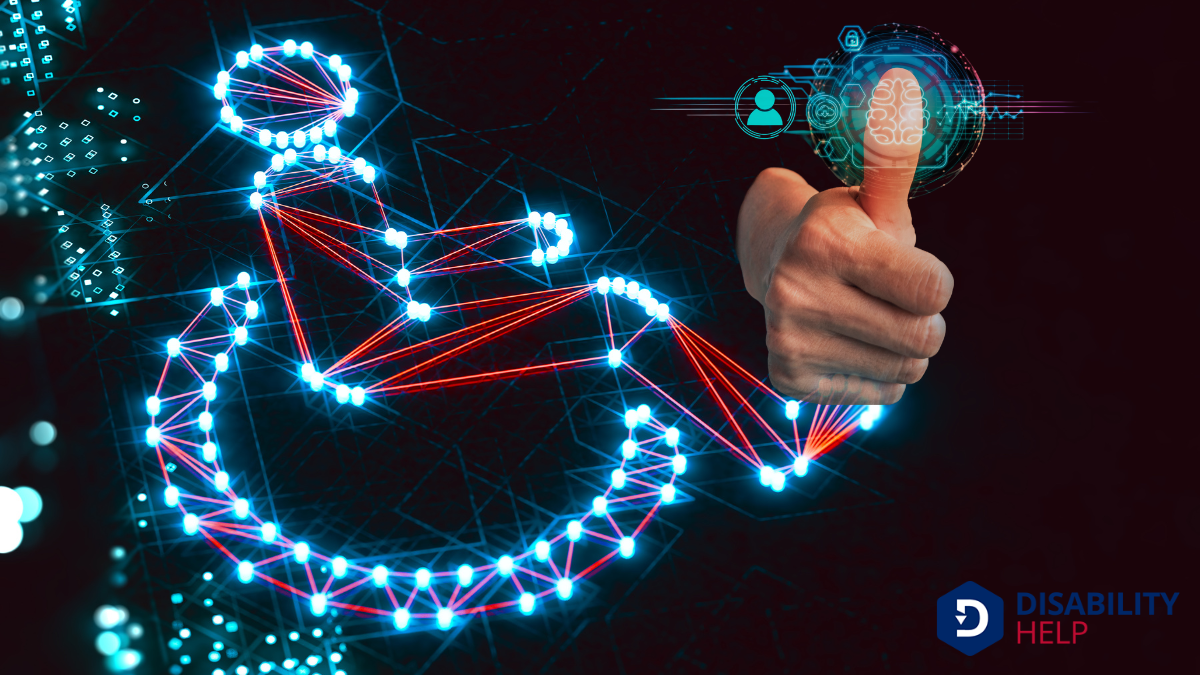In our career developmentThe process of managing life, learning, and work over the lifespan, including for individuals with d..., diverse abilities drive innovation and enrich team dynamics. By embracing inclusivity, we enhance productivity and problem-solving capabilities. We must recognize the unique strengths individuals with disabilities bring, as their perspectives fuel creativity and challenge conventional thinking. Accessible technology and supportive work environments are essential for success. Let’s understand how to overcome barriers and foster inclusivity, ensuring everyone thrives. Continue to explore these benefits to further empower your career journey.
Key Takeaways
- Disability: It promotes inclusivity by advocating for accessible hiring practices and workplace accommodationsModifications or adjustments in healthcare settings to support patients with disabilities..
- It provides resources and training to enhance awareness and understanding of disabilities in professional settings.
- Disability: In facilitates networking opportunities for individuals with disabilities, fostering career growth and development.
- The organization supports mentorship programsPrograms that pair individuals with disabilities with experienced professionals to provide guidance ..., offering guidance and support for career advancement.
- Disability: It encourages companies to embrace diversityThe inclusion of individuals from a wide range of backgrounds, including people with disabilities., leading to innovative problem-solving and organizational success.
Understanding Disability in the Workforce
When we think about the workforce, it’s vital to recognize how diverse abilities shape our professional environments. People with disabilities contribute unique perspectives and skills that enrich our teams. By understanding disability, we foster a more inclusive and productive workplace.
We need to acknowledge that disabilities aren't just physical but can be cognitive, sensory, or emotional. This awareness helps us create spaces where everyone feels valued and empowered to contribute.
Let's focus on communication and adaptability. These are fundamental in understanding and supporting our colleagues with disabilities. We should engage in open dialogues, ask questions, and actively listen.
The Impact of Inclusive Hiring Practices

Although often overlooked, inclusive hiring practices profoundly impact both organizations and individuals. By embracing diversity, we reveal potential and foster innovation.
- Broader Talent Pool: Inclusive hiring expands our reach, allowing us to tap into a wide range of skills and experiences. This diversity fuels creativity and problem-solving.
- Enhanced Employee Morale: When people feel valued for who they are, they're more engaged and motivated. A supportive atmosphere boosts overall workplace satisfaction.
- Improved Reputation: Companies known for inclusivity attract top talent and loyal customers. A diverse workforce reflects a company’s commitment to equality and progress.
- Increased Profitability: Studies show that diverse teams often outperform homogeneous ones. By including varied perspectives, we make decisions that drive success.
Embracing inclusivity isn't just right; it’s smart business.
Recognizing Unique Strengths and Perspectives
Recognizing unique strengths and perspectives takes our inclusive hiring practices to the next level.
When we appreciate the diverse abilities individuals with disabilities bring, we enrich our teams and foster innovation. It’s about understanding that everyone has something valuable to contribute. By focusing on strengths rather than limitations, we reveal potential that might otherwise go unnoticed.
Let’s embrace the creativity and problem-solving skills that often come from unique life experiences. These perspectives can lead to breakthroughs and enhance our collective success.
We must actively seek and celebrate these differences, knowing they drive progress. As we move forward, let’s commit to valuing diverse viewpoints, ensuring everyone feels seen and heard.
Together, we can build a stronger, more inclusive future.
Creating Supportive Work Environments
To create supportive work environments, we must prioritize inclusive workplace practices that recognize and value the contributions of individuals with disabilities.
It’s crucial to guarantee accessibilityThe design of products, devices, services, or environments to be usable by people with disabilities.... and provide accommodations, allowing everyone to perform at their best.
Inclusive Workplace Practices
Creating a supportive work environment for individuals with disabilities starts with fostering an inclusive workplace culture.
We must guarantee every employee feels valued and respected by implementing practices that embrace diversity. Here are the key steps to guide us:
- Education and Training: Conduct regular workshops to raise awareness about disabilities, encouraging empathyThe ability to understand and share the feelings of another, particularly important in understanding... and understanding among colleagues.
- Open Communication: Foster a culture where employees feel comfortable sharing their needs and concerns, promoting an open dialogue between management and staff.
- Mentorship Programs: Develop mentorship opportunities that pair individuals with disabilities with experienced colleagues who can offer guidance and support.
- Celebrating Diversity: Regularly recognize and celebrate the diverse contributions of all employees, reinforcing an atmosphere of inclusionThe practice of creating environments in which any individual or group can be and feel welcomed, res....
Accessibility and Accommodations
In our journey to foster an inclusive workplace culture, we must address the practical aspects of accessibility and accommodations. We can't overlook the crucial role these play in creating environments where everyone can thrive.
By understanding and implementing the right accommodations, we guarantee that all employees, regardless of ability, have equal opportunities to excel. It's our responsibility to actively listen to individual needs and provide the necessary tools and adjustments.
This might mean introducing assistive technologies, modifying workspaces, or offering flexible work hours. When we prioritize accessibility, we not only comply with legal standards but also demonstrate a commitment to valuing diverse talents.
Together, let's create workplaces where everyone feels welcomed, supported, and empowered to contribute their best.
The Role of Technology in Accessibility

Although many challenges still exist, technology plays a pivotal role in making workplaces more accessible for individuals with disabilities. When we think about technology and accessibility, several key innovations come to mind:
- Screen Readers: These tools convert text on a screen into speech or braille, enabling visually impaired individuals to navigate computer systems effectively.
- Voice Recognition Software: By allowing users to control devices and input data using voice commands, this technology supports those with mobility impairments.
- Assistive Listening Devices: These amplify sound directly to the listener, aiding individuals with hearing impairments in understanding conversations and participating fully in meetings.
- Adaptive Keyboards and Mice: Customized input devices help individuals with physical disabilities perform essential tasks efficiently.
Embracing these technologies can transform workplaces, fostering inclusivity and equal opportunities for all.
Strategies for Career Advancement
When considering strategies for career advancement, it’s essential to focus on both skill development and networking opportunities.
First, let’s enhance our skill sets by seeking training or certifications relevant to our fields. This not only improves our expertise but also increases our marketability. We should also attend workshops and webinars to keep up with industry trends.
Next, networking plays a key role. By connecting with professionals through social media platforms like LinkedIn, we can build relationships and exchange valuable insights.
Additionally, participating in industry events allows us to meet potential mentors and collaborators. Let's also not forget the importance of volunteering, which can provide practical experience and expand our professional circles.
Overcoming Barriers to Employment
As we work to overcome employment barriers, let's focus on maneuvering workplace accommodations effectively and building inclusive networks.
By understanding our rights and advocating for necessary adjustments, we can create environments where everyone thrives.
Together, we can build networks that support and uplift, fostering a more inclusive professional landscape.
Navigating Workplace Accommodations
Maneuvering workplace accommodations is essential for overcoming barriers to employment for individuals with disabilities. We must guarantee that these accommodations are effectively implemented, allowing everyone to contribute and thrive.
Let’s explore how we can achieve this:
- Identify Needs: Start by understanding specific accommodations required for each individual. This clarity helps tailor solutions that genuinely assist.
- Communicate Openly: Foster an environment where employees feel comfortable discussing their needs without fear of stigmaThe negative attitudes and discrimination faced by individuals with disabilities due to societal ste... or judgment.
- Implement Solutions: Use resources and technology to adaptA grassroots disability rights organization in the U.S. that focuses on promoting community-based se... workspaces, providing tools such as voice recognition software or modified workstations.
- Evaluate Regularly: Continuously assess the effectiveness of accommodations, making adjustments as needed to guarantee they remain suitable and supportive.
Building Inclusive Networks
Building inclusive networks is a significant step in overcoming barriers to employment for individuals with disabilities. When we foster connections, we create opportunities that mightn't be available otherwise.
By actively engaging with diverse communities, we gain perspectives that help break down misconceptions about disabilities. Let’s focus on building relationships with mentors, colleagues, and industry professionals who value diversity and inclusion. These connections can provide support, guidance, and even job leads.
It’s essential we advocate for accessible networking events and platforms, ensuring everyone can participate fully. By doing so, we empower individuals with disabilities to showcase their skills and talents.
Together, we can create an environment where everyone’s contributions are recognized and valued. Let’s commit to building networks that embrace and celebrate diversity.
The Benefits of Diversity in Innovation

When we embrace diversity, innovation flourishes. Our unique perspectives blend into a rich tapestry of creativity, fueling breakthroughs and fostering growth.
By including different voices and experiences, we reveal new pathways to problem-solving and opportunity. Let’s consider how diversity drives innovation:
- Varied Perspectives: Different backgrounds lead to fresh ideas, challenging conventional thinking, and sparking creativity.
- Increased Creativity: A mix of ideas and experiences generates innovative solutions, breaking boundaries and introducing new concepts.
- Improved Problem-Solving: Diverse teams approach problems with a broader range of strategies, leading to more effective solutions.
- Enhanced Adaptability: Organizations that embrace diversity can better navigate change, staying resilient in a rapidly evolving world.
Conclusion
In reflecting on disability's role in career development, let's embrace inclusivity and recognize the unique strengths each individual brings to the table. By fostering supportive environments and leveraging technology, we can break down barriers and advance careers for everyone. Inclusive hiring practices aren't just ethical—they're innovative, driving diversity that fuels creativity and growth. Together, we're not just changing workplaces; we're reshaping the future of work for a more equitable and dynamic world.






